The description read:
“Manzanillo Ecological Reserve,” native ground of the Galapagos’ Giant Tortoises. What to bring: closed shoes, long pants, sun protection, water, hat, sun glasses, insect repellant, and money.”
Money?
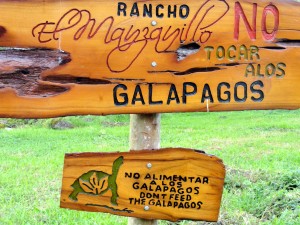
We landed on the island of Santa Cruz, boarded a bus and left the dry shore area behind as we climbed into the rainforest. Carlos Guerrero, owner of Rancho Manzanilla, is a man of vision. Long before the road went in, Guerrero traveled to various areas of the rain forest until he found the perfect spot. Then he went back to town, and asked to purchase 80 hectares of land so he could grow coffee. Officials reminded him there was no infrastructure. No problem, Guerrero insisted. So they quoted Guerrero a price.
Hmmm. Seems Guerrero didn’t have the cash, but he did have ten cows. He got the land. Guerrero turned around and sold 35 hectares of the land, leaving him with 41 hectares. Guerrero planted coffee trees, and today offers visitors a sample of the results. [Galapagos Coffee is considered one of the best gourmet coffees in the world.]
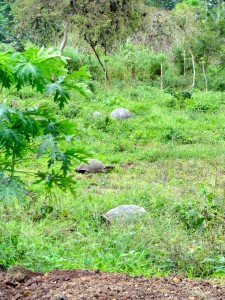
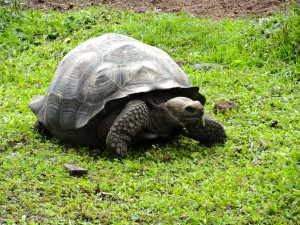
But, Guerrero didn’t purchase the land just to build a farm. The land is abuts the Tortoise Reserve. Guerrero encouraged the animals to roam freely on his land, built a visitor center with rest rooms, snacks, and souvenirs. Once the road was in place, Guerrero let tourist outlets know he had facilities for visitors to interact with giant tortoises.
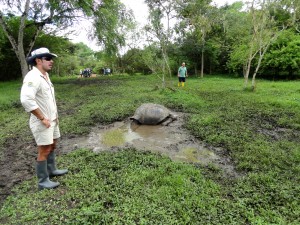
Guerrero also provides wellington boots free of charge. Considering the mud, this amenity is second only to clean rest rooms.
Factoids
The Giant Tortoise plays an important role in Galapagos History. The very name Galapagos came from the tortoises’ saddle-back shell. Early explorers named the beast after the Spanish word for saddle – galapago.
Tortoise availability brought explorers, pirates, whalers, and all manner of folks to the Galapagos Islands, because the Galapagos Tortoise can live up to a year without food or water. Sailors could fill the ship’s hold with tortoises and have fresh meat as needed. Not surprisingly, this practice decimated the tortoise population.
The tortoises arrived in the islands somewhere between two and three million years ago from the South American mainland, either on vegetation rafts or by floating. The next challenge was to adapt to the dry volcanic environment with its frequent droughts. The front carapace of saddle-back shells curves upward allowing the tortoise to stretch his or her head to reach higher vegetation.
Truth or Fiction?
There is a story that once upon a time, Steven Spielberg visited the Galapagos and was so taken with the Giant Tortoises that he said he would put them in his next movie. The film was E.T., The Extra-Terrestrial.
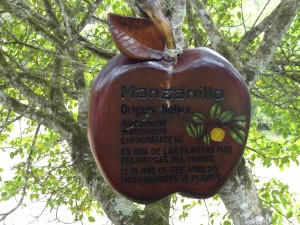
Little Apples of Death
Endemic to the Galapagos Islands is a fruit tree, commonly called the Poison Apple Tree – officially the Manzanilla tree or manzanilla de la muerta which translates as “little apples of death.” Every part of this tree is toxic. Touching the plant causes severe dermatitis in the form of an immediate rash, blistering, and/or burning pain. It’s better to get wet from the rain than take refuge under the tree’s boughs. Rainwater dripping off the tree is laden with plant toxins that blister skin. The Galapagos Tortoise eats the fruit with impunity. Humans are wise to avoid it. At the very least, ingesting the fruit can cause severe gastroenteritis. Unless you’re a Galapagos Tortoise.
Puerto Baquerzizo Morino
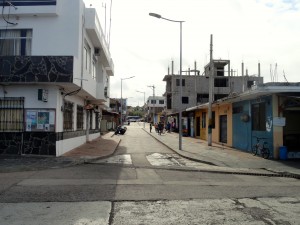
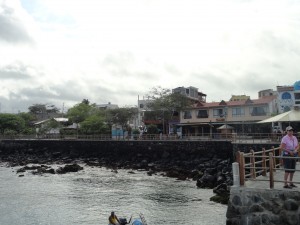
Back at the shoreline, visitors can stroll the small town of Puerto Baquerzizo Morino, the capital of the Galapagos Islands. The sea lions are pretty sure the town belongs to them. After all, they were here first.
Acknowledgements:
Featured Image: Sign at Galapagos National Park Visitor Center, opened in 1998.
Photos by Author. All Rights Reserved.
Candice Gaukel Andews. “Giant Galapagos Tortoise Makes a Movie.” July 19, 2012. Good Nature Travel.
Galapagos Conservancy.Here.
More information on Galapagos Poison Apple Tree Here and Here.

Sandra Wagner-Wright holds the doctoral degree in history and taught women’s and global history at the University of Hawai`i. Sandra travels for her research, most recently to Salem, Massachusetts, the setting of her new Salem Stories series. She also enjoys traveling for new experiences. Recent trips include Antarctica and a river cruise on the Rhine from Amsterdam to Basel.
Sandra particularly likes writing about strong women who make a difference. She lives in Hilo, Hawai`i with her family and writes a blog relating to history, travel, and the idiosyncrasies of life.

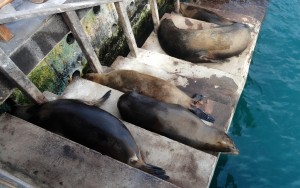

So interesting! The description of the poison manzanilla tree reminded me of the chapter in Life of Pi when the castaway boy and tiger land discover an island made of trees. The island turns out to be very deadly, so they are forced to put out to sea again.
I hear so much about Galapagos but never a story like yours! Loved it!
You look very natural on the camel:) 🙂 Mahalo for sharing your stories/history!! Interesting…..always!xoxoxodk
All I want to know is: did you bring back any Galapagos Coffee!?? One must share this stuff you know!!
Yes, the Galapagos Islands were full of surprises! I didn’t bring back any coffee — spent my money on gifts. Probably should have taken more. But, ubiquitous Starbucks has a blend of Galapagos coffees — and I’m sure other purveyors of gourmet coffees stock it. On the other hand, since both the Galapagos and the Hawaiian Islands are volcanic, the coffee flavors may be similar?